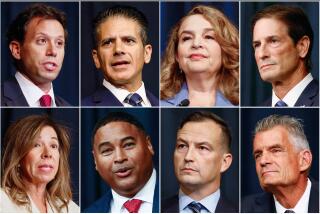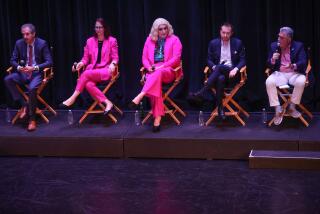Candidates Hold Back on TV Ads
A surge in the cost of television advertising is promising to reshape the ad wars in the Los Angeles mayoral race, forcing the campaigns to delay airing most of their commercials until the final few weeks of the race, according to the candidates’ media consultants.
Faced with a creeping rise in ad rates over the last four years, along with the pressure to air more commercials because of a decrease in broadcast ratings, many of the candidates are expected to hold on to the bulk of their ammunition until the last several weeks before the March 8 election.
“You have a real hard time taking the amount of money you have and stretching it over more than two or three weeks to get the kind of volume you normally need,” said David Doak, media consultant for City Councilman Antonio Villaraigosa.
The likely result: a more intense, harsher campaign, as the candidates joust to define themselves and their opponents in a compressed time frame.
“There’s probably going to be some temptation for negativity here,” said Bill Carrick, media strategist for Mayor James K. Hahn. “We may see some desperation in order to get attention, with both inflammatory charges and half-baked ideas.”
Television ads are the most effective way to reach voters across the sprawling city, and the costlier commercials will make it even more difficult for candidates with limited resources to gain traction. The new dynamic also gives well-funded independent groups a greater opening to dramatically affect the race by beating the campaigns to the air with their own television ads.
Political experts caution that media strategies are fluid, as ad rates fluctuate and candidates adjust their plans in response to their competitors. But there’s no question that the 2005 mayoral race has seen curtailed campaign advertising.
At this point in the 2001 race, television viewers were being pelted by competing ads from a half-dozen mayoral candidates.
This year, with a little more than four weeks left before election day, former Assembly Speaker Bob Hertzberg is the only one on the airwaves, with a $250,000 advertising buy characterized as modest -- for this year -- by his competitors.
“We thought they’d be on a little before this,” said one executive at a local station, who requested anonymity when discussing advertising.
One of the constraints facing the mayoral contenders is that they are reined in by campaign finance rules. All five major candidates agreed to participate in the city’s public matching funds program, which limits their total spending in the first round of the election to $2.2 million each.
That cap will be lifted if an outside group spends more than $200,000 on an independent campaign -- a prospect most analysts consider likely. In 2001, Indian tribes, unions and the Democratic and Republican parties, among others, spent a total of more than $2.5 million trying to influence the race for mayor.
For now, however, Hahn -- who had raised $2.7 million by the third week in January, the last reporting period -- appears to be the only candidate who has raised enough money to benefit from a lifting of the $2.2-million cap.
Meanwhile, inflation has driven the cost of television advertising up about 15% since four years ago, when the country was entering an economic downturn, according to several media buyers.
“It’s just a matter of supply and demand,” said ad-maker Steve Murphy, who is working for Hertzberg. “We’ve had a recovery, and the demand is pretty good.”
Complicating the equation is another factor: Nielsen’s switch last year from using handwritten viewer diaries to electronic “people meters” to measure television ratings in major markets. The controversial change resulted in a drop in ratings for many broadcast programs, to the dismay of network executives.
Advertisers use the ratings to calculate how many commercials they need to run in order to reach a certain number of consumers. Most campaign media buyers agree that an advertising buy of 1,000 rating points a week -- in which the average viewer would see the commercial an estimated 10 times -- is necessary to truly saturate a market.
But because of ongoing debate over the new Nielsen methodology, many television stations have refused to drop ad rates for shows that have experienced a decline in ratings.
“We as a station are refusing to lower our prices because the numbers appear to be lower,” one local station executive said. “If we were worth ‘x’ last week, we know we’re worth ‘x’ this week.”
For the campaigns, that means buying more ads to achieve the same saturation. The bottom line: The cost of a 1,000-point buy has risen from less then $500,000 four years ago to about $750,000 now, according to several media consultants.
Faced with limited budgets, the mayoral hopefuls may be able to purchase only a small round of early ads, waiting until the end of February to saturate the airwaves.
“It limits most people to the end of the campaign,” said Jewett Walker, campaign manager for City Councilman Bernard C. Parks.
With absentee ballots being accepted as early as Monday, however, the candidates -- especially those with low name identification -- cannot afford to wait until the final weeks to make their case to voters. Most campaigns say they will try to get on the air another way: for free.
But they will be competing for media coverage with other local stories, including the Michael Jackson trial and the Hollywood awards shows.
“This is an extremely tough city to communicate in, a very tough media environment with an enormous number of distractions,” said Hahn strategist Carrick. “I think it’s going to be much more difficult to get the public’s attention and sustain it.”
Consultants expect some candidates to lob hardballs in order to make headlines. Many of Hahn’s challengers have already suggested that his administration is “corrupt,” seizing on an investigation into city contracting.
Carrick pledged that the mayor would fire back against those allegations.
“We’re not going to sit around very long and listen to them talk about corruption and campaign finance when there are plenty of vulnerabilities that they have,” he said. “We will make this a comparative choice.”
Hahn demonstrated his willingness to use hard-hitting tactics in the 2001 race, when he aired a controversial commercial attacking Villaraigosa for writing to the White House on behalf of a convicted cocaine trafficker. (The former Assembly speaker was among a half-dozen local politicians, including Hertzberg and Cardinal Roger M. Mahony, who wrote letters seeking a review of Carlos Vignali’s case.)
The ad -- which featured a grainy image of Villaraigosa, along with footage of a crack pipe and a razor blade cutting cocaine -- was criticized by many as inflammatory. Carrick, who maintains that the commercial was appropriate, said the campaign has not decided whether to run a similar ad this year.
Some of his competitors warned that going negative in the early round of the election could backfire, since such tactics are unpredictable in a crowded field.
In the final weeks of Iowa’s presidential caucuses last year, former Vermont Gov. Howard Dean and Missouri Rep. Richard Gephardt pummeled each other with attack ads, allowing Massachusetts Sen. John F. Kerry and North Carolina Sen. John Edwards to gain steam. Kerry and Edwards ended up capturing first and second place, respectively.
“In a two-person race, there’s only one place voters can go if they’re turned off to a candidate,” said Doak, Villaraigosa’s ad-maker. “In a multi-candidate field, they have a lot of places to go.”
More to Read
Get the L.A. Times Politics newsletter
Deeply reported insights into legislation, politics and policy from Sacramento, Washington and beyond. In your inbox three times per week.
You may occasionally receive promotional content from the Los Angeles Times.










